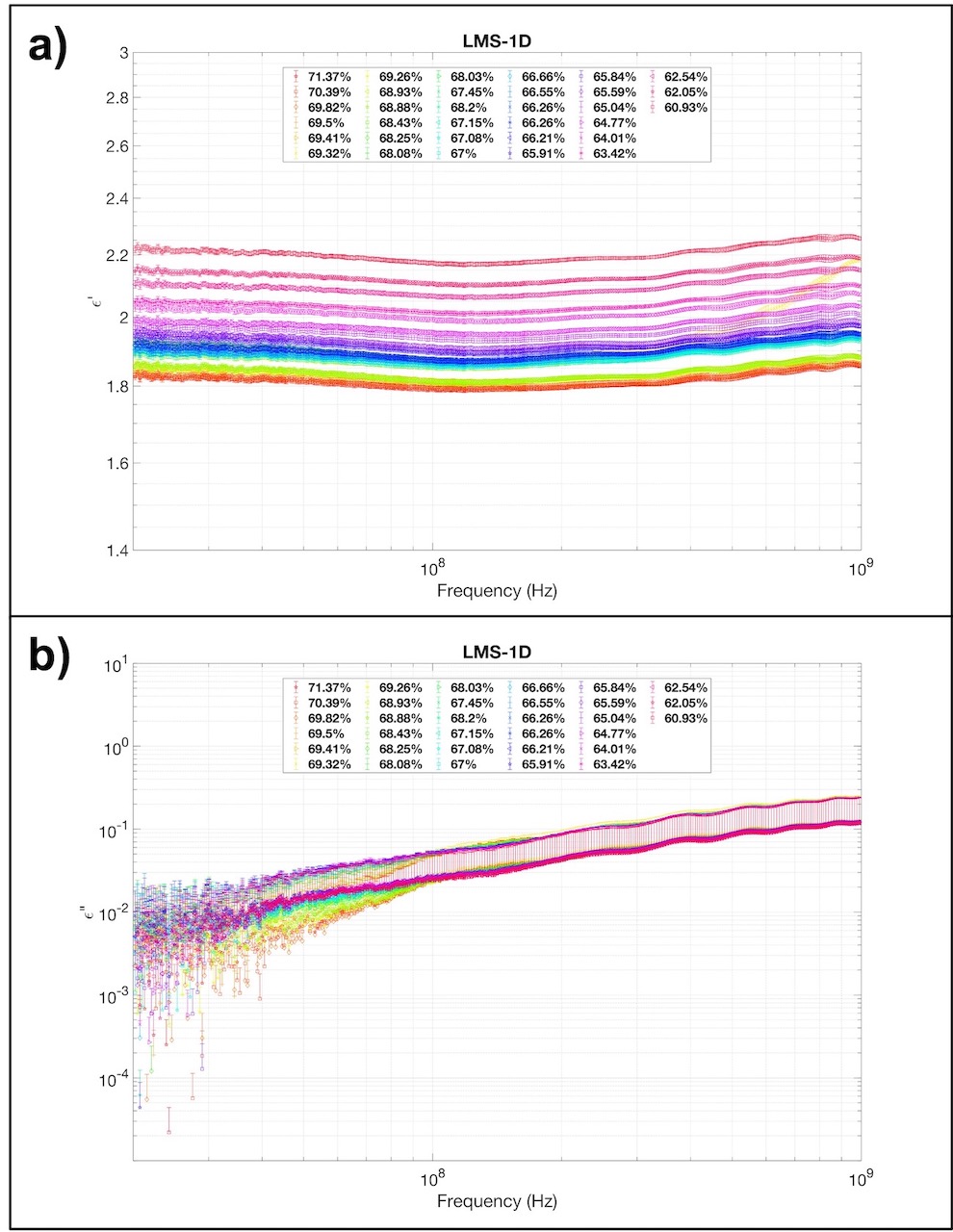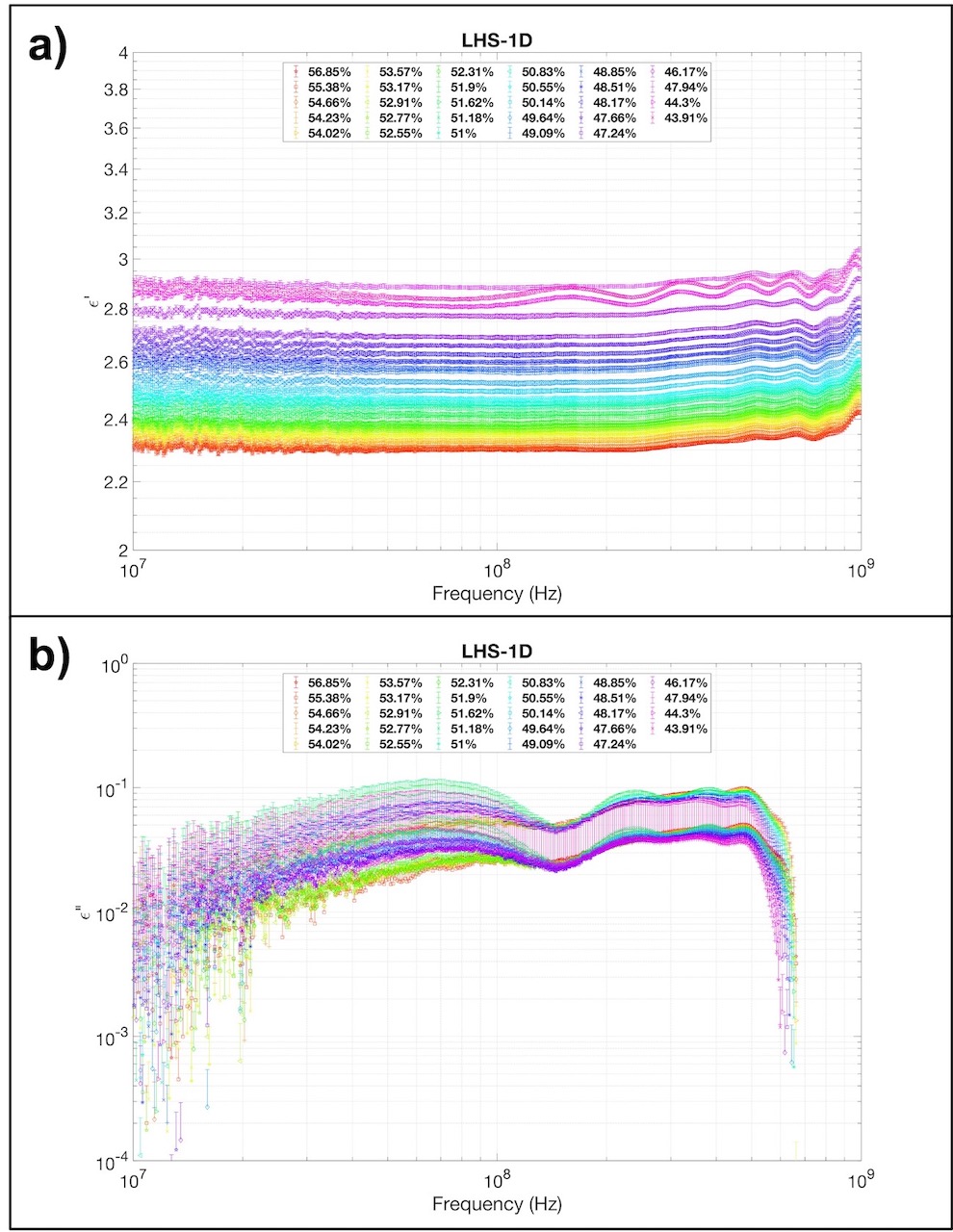Dielectric measurements of lunar soil analogues at different compactions within the Melody project.
- 1Mathematics and Physics Department of Roma Tre University Rome, Italy (chloe.martella@uniroma3.it)
- 2INAF-IAPS, Rome, Italy (federico.tosi@inaf.it)
Introduction: Several future missions to the Moon will be devoted to robotic and human explorations in search for ice deposits and other resourses. Ground Penetrating Radar (GPR) is considered a fundamental geophysical instrument to detect water ice inside the regolith and to map the distribution of the volatiles in the lunar polar regions. The success of GPR survey relies on the capability to discriminate between dry and ice-saturated regolith or to detect lenses of relatively pure water ice. To reach this goal an intense laboratory activity is required to characterize the radar response of the lunar regolith as a function of mineralogical composition and different physical conditions (e.g., compactions, temperature, ice content). Here, we present new dielectric measurements of lunar regolith simulants in a broad range of frequencies and for different soil porosities, to improve the interpretation of radar data collected on the Moon. Such measurements have been carried out in the framework of the PrIN INAF “MELODY” (Moon multisEnsor and LabOratory Data analysis) research project, which is devoted to combining past and present lunar data to improve our knowledge on the lunar surface and shallow subsurface properties.
Laboratory measurements: GPR measurements allow one to retrieve signal wave velocity and attenuation in the lunar subsurface [1]. Such parameters are related to complex dielectric permittivity and magnetic permeability, from which some chemical-physical properties of the lunar soil and rocks can be inferred. We apply dielectric spectroscopy techniques for two pairs of commercially available, certified lunar soil analogues (Exolith Lab, 2021a, 2021b) [2, 3] to characterize the radar response of the regolith as a function of mineralogical composition and different physical conditions (e.g., temperature, porosity, and ice content). The investigation of these analogues helps us understand the most reliable lunar soil. Such analogues reproduce the composition of both lunar maria and highlands. The maria analogues are LMS-1D (particle size < 0 – 30 μm) and LMS-1 particle size < 0.04 – 300 μm). The highlands soil simulants are LHS-1D (particle size < 0.04 – 35 μm) and LHS-1 (particle size < 0.04 – 400 μm). The analogues mineralogy are reported in Tab. 1 and Tab. 2.
The measurements are performed at room temperature in the frequency range 100 kHz to 3 GHz, using a Vector Network Analyzer VNA (Agilent E5071C). The VNA ultimately provides the the electromagnetic parameters of the simulant through the Nicholson-Ross-Weir algorithm (NRW) [4]. This method allows one to retrieve both complex dielectric permittivity and magnetic permeability; however due to the negligeble magnetic properties of the samples, here only the dielectric permittivity is reported. Measurements are performend with a coaxial probe line characterized by a multiwire shield cage. Regolith analogues were first oven-dried at 105°C for 24 hours to remove residual water; then the samples are inserted in the teflon cage and different compaction are obtained through a vibration plate.
Results and future work: Fig. 1 (a and b) report the real and imaginary parts of the dielectric permittivity as a function of frequency for the Maria simulant having the smallest particle size range. Fig. 2 (a and b) illustrates the same parameters for the highland simulant. Note that for the two samples a different range of compaction is obtained. The real part of permittivity is frequency independent and decreases with increasing porosity because of the air trapped in the pores, as expected. For lunar maria it ranges from 1.8 to 2.2 (𝜙 from 70% to 60%), while the highland simulant shows higher values between 2.3 and 2.9 (𝜙 from 56% to 44%). Re- garding the imaginary part, it does not show a dependency on porosity, while it shows the same trends at every compaction over the frequency range for both simulants. The next step of the project will be the characterization of the dielectric behaviour of the simulants in a broad range of temperatures (200K – 373K).
Acknowledgements: We acknowledge support from the research project: “Moon multisEnsor and LabOratory Data analYsis (MELODY)” (PI: Dr. Federico Tosi), selected in November 2020 in the framework of the PrIN INAF (RIC) 2019 call.
References: [1] Jol, Harry M., ed. Ground penetrating radar theory and applications. elsevier, 2008. [2] Exolith Labs, U. of C.F LMS-1 Lunar Mare Simulant Spec Sheet (2021). [3] Exolith Lab, U. of C.F LHS-1 Lunar Highland Simulant Spec Sheet (2021). [4] Nicolson, A. M., & Ross, G. F. (1970). Measurement of the intrinsic properties of materials by time-domain techniques. IEEE Transactions on instrumentation and measurement, 19(4), 377-382.

Figure 1: Real (a) and Imaginary (b) part of the permittivity as function of frequency of sample LMS-1D at varying compaction.

Figure 2: Real (a) and Imaginary (b) part of the permittivity as function of frequency of sample LHS-1D at varying compaction.
Table 1: Mineralogy of lunar Highlands analogues LHS-1 and LHS-1D.
Table 2: Mineralogy of lunar Maria analogues LMS-1 and LMS-1D
How to cite: Martella, C. H., Cosciotti, B., Lauro, S. E., Mattei, E., Tosi, F., and Pettinelli, E.: Dielectric measurements of lunar soil analogues at different compactions within the Melody project., Europlanet Science Congress 2022, Granada, Spain, 18–23 Sep 2022, EPSC2022-243, https://doi.org/10.5194/epsc2022-243, 2022.

